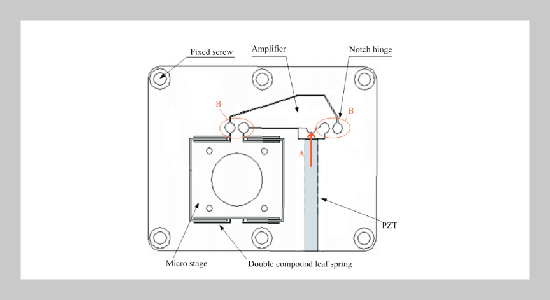REFERENCES
- [1] SIA, The National Technology Roadmap for Semiconductor, 1997.
- [2] Ryu, J. W., Gweon, D. G. and Moon, K. S., “Optimal Design of a Flexure Hinge Based XYθ Wafer Stage,” Precision Engineering, 21(1), pp. 18-28 (1997).
- [3] Yang, R., Jouaneh, M. and Schweizer, R., “Design and Characterization of a Low-Profile Microposioning Stage,” Precision Engineering, 18(1), pp. 20-29 (1996).
- [4] Lee, C. W. and Kim, S. W., “An Ultra-Precision Stage for Alignment of Wafers in Advanced Microlithography,” Precision Engineering, 21(2-3), pp. 113-122 (1997).
- [5] Elmustafa, A. A. and Lagally, M. G., “Flexural-Hinge Guided Motion Nanopositioner Stage for Precision Machining: finite element simulation,” Precision Engineering, 25, pp. 77-81 (2001).
- [6] Dai, R., Xie, T. B. and Chang, S. P., “A Micro-Displacement Stage for Scanning White-light Interferometry,” Journal of Physics: Conference Series, 13, pp. 94-97 (2005).
- [7] Howell, L. L., Compliant Mechanisms, John Wiley & Sons, New York, U.S.A. (2001).
- [8] Chang, R. J. and Wang, Y. L., “Integration Method for Input-Output Modeling and Error Analysis of Four-bar Polymer Compliant Micromachines,” Journal of Mechanical Design, 121(2), pp. 220-228 (1999).
- [9] Fu, S. J., “Optimal Design and Characterization of a Nanometer Poisoning Stage,” Master thesis, Department of Mechanical Engineering, Chun-Hsin University, Taiwan, ROC (2001).
- [10] Hsiao, G. M., “Tolerance Design and Analysis of a Nano-Resolution Micro Stage,” Master thesis, Department of Mechanical Engineering, Chun-Hsin University, Taiwan, ROC (2004).
- [11] Sigmund, O., “On the Design of Mechanisms Using Topology Optimization,” MECH. STRUCT. & MACH., 25(4), pp. 493-524 (1997).
- [12] Huang, S. C. and Lan, G. J., “Design and Fabrication of a Micro-Compliant Amplifier with a Topology Optimal Compliant Mechanism Integrated with a Piezoelectric Microactuator,” Journal of Micromechanics and Micro-engineering, 16, pp.531-538 (2006).
- [13] Shih, C. J., Lin, C. F. and Chen, H. Y., “An Integrated Design of Flexure Hinges and Topology Optimization for Monolithic Compliant Mechanism,” Journal of Integrated Design & Process Science, 10(3), pp. 1-16 (2006).
- [14] BendsØe, M. P. and Haber, R. B., “The Michell Layout Problem as a Low Volume Fraction Limit of the Perforated Plate Topology Optimization Problem: an Asymptotic Study,” Structural Optimization, 6, pp.263-267 (1993).
- [15] Mlejnek, H. P. and Schirrmacher, R., “An Engineering’s Approach to Optimal Material Distribution and Shape Finding,” Computer Method in Applied Mechanics and Engineering, 106, pp. 1-26 (1993).
- [16] Rozvany, G. I. N., “Aims, Scope, Methods, History and Unified Terminology of Computer-Aided Topology Optimization in Structural Mechanics,” Struct. Multidisc. Optim., 21, pp. 90-108 (2001).
- [17] Kirsch, U., Structural Optimization, Springer- Verlag (1993).
- [18] Svanberg, K., “The Method of Moving Asymptotes - a New Method for Structural Optimization,” Int. J. Numer. Meth. Eng, 24, pp.359–373 (1987).
















